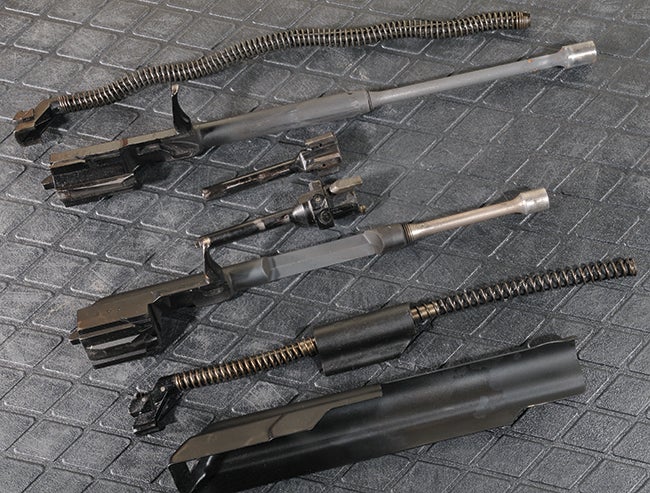It has been a little while since our last installment of A Short (Stroke) History, but in this article I intend to wrap up my coverage of tappet-operated rifles by cataloging most of the post-war developments of this mechanism.
One left-over from my last article developed during World War II was the M1E11, a modification of the M1 Garand rifle to tappet gas operation. No pictures are available of this rifle, and it suffered overheating problems like many of the Garands made with modified gas systems, but it is worth mentioning anyway.
Winchester LMR
The next major entry in the ledger of tappet operated rifles is the Winchester LMR. I covered the LMR in a previous post, which is reproduced below:
Forgotten Weapons, an excellent website for the gun history buff, posted a copy of the manual for the Winchester Light Military Rifle back in 2011. The LMR (shown in the title image) is an obscure competitor to the early AR-15, against which it competed several times in the late 1950s. A relative of the highly successful M1 Carbine, the LMR was based on the Carbine’s immediate predecessor, the Williams Carbine, which itself had designed as an alternative to the M1 Carbine.
The LMR was not unlike the later Ruger Mini-14 in design, though it differed in being far lighter (even lighter – at 4.9 pounds unloaded – than its cousin the M1 Carbine), and in being chambered for an oddball .22 caliber cartridge, the .224 caliber E2. This round had a very short, stubby 53 gr bullet fired at 3,300 ft/s muzzle velocity, but was otherwise compatible with .223 Remington (at the time .222 Remington Special) chambered weapons. For most tests before 1960, in fact, AR-15s were tested using the E2 cartridge for logistics reasons. It has been speculated that it was the short, easily stabilized bullet of the .224″ cartridge that masked the poor ability of the early AR-15’s 1-in-14″ twist barrel to stabilize the longer 55gr bullet of .223 ammunition in cold weather, until January of 1963, when the 1-in-12″ twist barrels were introduced.
The LMR was extensively tested, and found inferior to the AR-15 rifle in most respects. One such evaluation is the subject for today’s article; it was conducted in July of 1958 at Fort Benning, Georgia. Contained in the document are several interesting results, such as the Winchester LMR proving more accurate in semiautomatic and fully automatic fire both than the M14, but also somewhat less reliable and less resistant to the environment.
In the end, two major problems spelled the end of the Winchester rifle: In their mad rush for lighter weight, the Winchester engineers created a rifle that was fragile to handle (in particular, the handguard and trigger housing are cited as breaking with hard use), and the stubby bullet of the .224″ cartridge produced undesirable velocity loss over distance. The AR-15, which proved more reliable, less susceptible to parts breakage, and which possessed superior ballistics, continued in its development, eventually becoming the standard issue M16 rifle of the US Army.
Ingram SAM
This rifle is a similar evolution to the Winchester LMR, only taking as its ancestor the M1 Carbine, not Williams’ similar design. It was designed by Gordon Ingram, inventor of the MAC-10, and may have gotten a contract with the Somali government (the result of which is unclear). Jim Sullivan had an interesting anecdote about the development of the SAM in his interview with Small Arms Review:
SAR: At the end of that project you came back to the US?
Jim Sullivan: Yes. I met a US submachine gun designer named Gordon Ingram. I had actually known him for a while and one day he and his “angel” who had funded one of his programs ended up there at Beretta. We all went out to dinner together. This was right about the time things were falling apart on the Beretta project, and it looked like there was going to be no completion on this thing, and his angel asked me to do the C-Mag for him – it was part of my Italian project ideas. Actually, he feigned interest in the C-Mag. What he wanted me to do, though, and this ended up kind of as a fight between myself and Gordon, was to take Gordon’s program over, where in this guy’s mind, Gordon had kind of messed up. There were problems with the gun. That’s what the guy wanted me to do. Gordon had been working on something similar to the Mini 14 idea in 5.56, but it was based more on the M1 Carbine.
SAR: He didn’t have a drum magazine for this…
Jim Sullivan: No, it was an assault rifle. The gun I did for Beretta had a double drum magazine. It was the predecessor of the C-Mag. I took the innards out of my Italian design and that eventually became the C-Mag, but that was my design, my invention. It didn’t belong to Beretta yet, because they hadn’t completed the program because our agreement was they had to fund the whole thing before I made assignment. They hadn’t done that. So, I was with Gordon and his financial backer, and I mentioned this C-Mag – it wasn’t called that at the time – and he got all excited about it. He wanted me to leave Beretta, and that was fine with me because it was all coming apart. I still had to complete some stuff, so I said, “Okay, in two months we’ll get on this C-Mag.” Before the two months was up, it became clear that what he really wanted me to work on was Gordon Ingram’s program. Well, I wouldn’t do that. The thing that Gordon and I had the fight over was that this guy that was funding all of this, he was setting up in Somalia, in Mogadishu. I had gone down there, still thinking the interest was in my magazine, and it wasn’t. Gordon, when he found out I was going down there, he thought I was stabbing him in the back. I wasn’t, but he thought that.
SAR: Did you ever get that squared away with Gordon?
Jim Sullivan: Yeah, but it took a while. He never did quite trust me after that, which is too bad. Anyway, I did make the deal on the magazine with the guy. He was kind of an entrepreneur. It wasn’t his money, he had a group of investors lined up, and one of them was the ex-governor of Georgia, Carl Sanders. Sanders was the real investor in this thing, and then he and this entrepreneur had a falling out, and neither one of them owned enough of it, and they got Sylvia involved, otherwise it would have fallen apart.
Steyr AUG
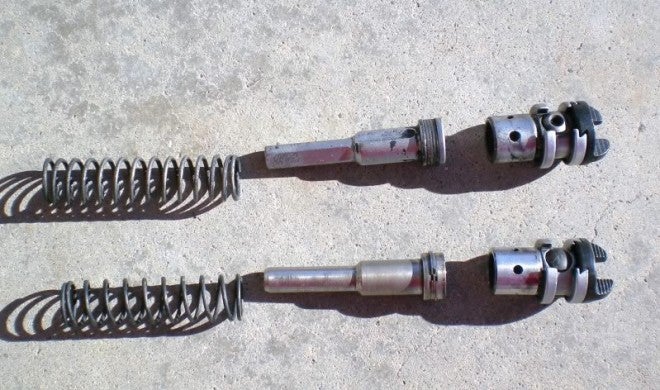
Two Steyr AUG gas plug assemblies, from two different makes of AUG. Note the generous return spring for what is otherwise a fairly conventional tappet. Image source: ar15.com.
As mentioned in the first article, the line between a “conventional” short-stroke piston and a tappet is infinitesimally fine. The Steyr AUG is a great example of this. Like a tappet, it has a small, fast-moving mass with sealing rings captured within a gas block. Unlike a tappet, it has its own return spring. The tappet/piston impinges directly onto the left bolt carrier extension to operate the rifle.
Howa Type 89
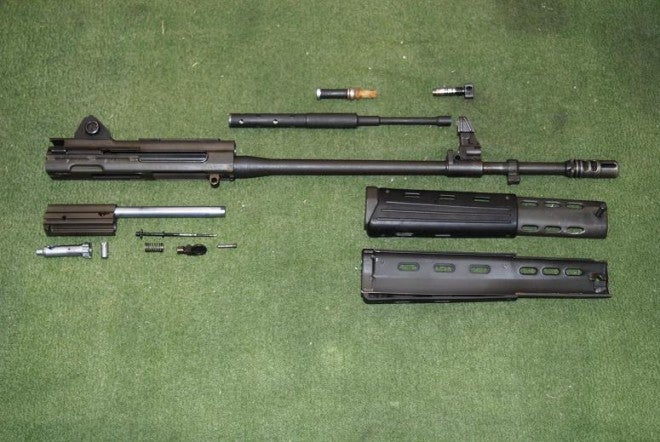
A disassembled Howa Type 89. Note the generous tappet with its discolored “wadding”. The tappet impinges on the bolt carrier extension. Image source: forgottenweapons.com.
The Howa Type 89 is often considered to be a derivative of the AR-18. That makes sense; Howa did produce AR-18s and 180s, after all, and the two designs look quite a bit alike. Except, the Type 89 really isn’t an AR-18 clone. Many elements, especially the metal stamping are present, but most of the diagnostic features of an AR-18 clone, such as the dual guide rods and conventional, segmented short-stroke piston, are not present. In fact, the Type 89 uses a tappet as its method of operation, and a rather large one at that. Unlike the classic Williams tappet, however, the Type 89 first ports gas down a gas tube, like an AR-15, then this gas impinges on the wide tappet, which itself drives the bolt carrier. The tappet is limited in its travel – less than an inch – by the stamped steel gas tube that connects the upper receiver to the gas block.
Forgottenweapons.com has a more extensive set of photos showing the disassembly of the Type 89, including close-ups of its large tappet.
FN F2000
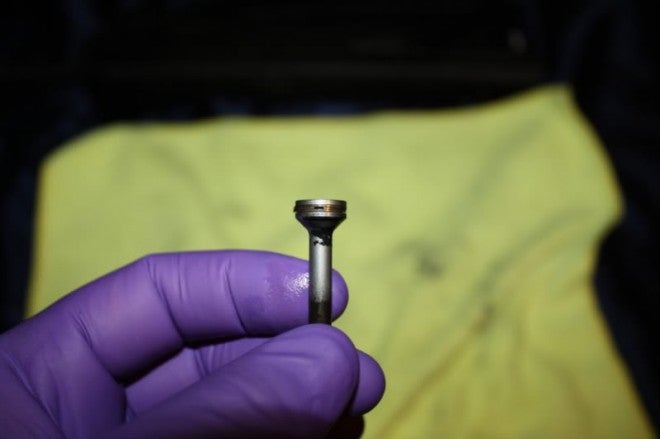
The F2000’s tappet. Though based on the AUG’s, it is reduced in size and has no return spring. Image source: fnforum.net.
The F2000 is heavily based on the AUG, but reduced in scale to accommodate the forward ejection system. The right bolt carrier extension/guide rod has been eliminated, and the tappet and left extension greatly reduced in size. Notably, the tappet in the F2000 looks very much like the same part in the later FN SCAR.
FN SCAR

Very similar indeed to that of the F2000’s tappet is that of the FN SCAR. This one’s sealing ring is broken. Image source: fnforum.net.
The SCAR uses a fairly conventional tappet mounted inside the gas block with sealing rings on the piston head. This tappet impinges directly onto the front of the SCAR’s massive bolt carrier, operating the rifle without transmitting heat or fouling to the moving parts group.
POF P415/416
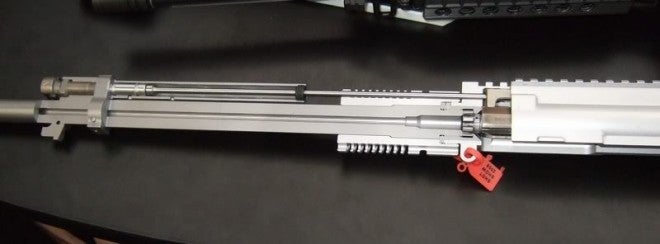
A cutaway view of the POF gas piston system. The lightweight operating rod and separate tappet are both highly visible in this view. The stroke of the piston varies greatly depending on the model of rifle. Image source: ar15.com.
Occupying a similarly gray area to the AUG, but as a foil to it, the POF P416 has a very conventional looking short-stroke operating rod… That lacks its own return spring, and is operated by a tappet. The operating rod, too, is lighter than that of a conventional short-stroke rifle, begging the question: Is this a tappet operated rifle, or a conventional short-stroke? It’s both, perhaps.
POF is very eager to have others understand how their system works, and to that end they also have created a video showing the operation of the system. Evident are the tappet’s initial travel until it makes contact with the operating rod, as well as the short stroke of the operating rod:
Saiga 12/Vepr 12
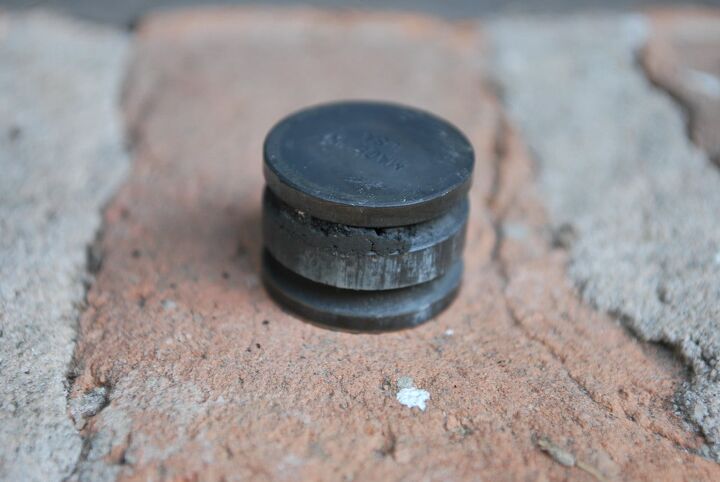
The massive tappet of the Saiga 12 shotgun. The diameter of this part is the same as that of the operating rod; better than half an inch in diameter. Image source: ar15.com.
Despite possessing a very beefy AK-style operating rod, the Saiga 12 actually differs from the standard AK by having a very wide, very massive tappet (colloquially called a “puck”) contained in the gas block. This tappet is clearly designed to operate using the relatively low pressures generated by shotgun shells, though its inclusion in a design that is otherwise quite traditionally AK is a little puzzling. The Vepr 12 uses a similar system.
VHS
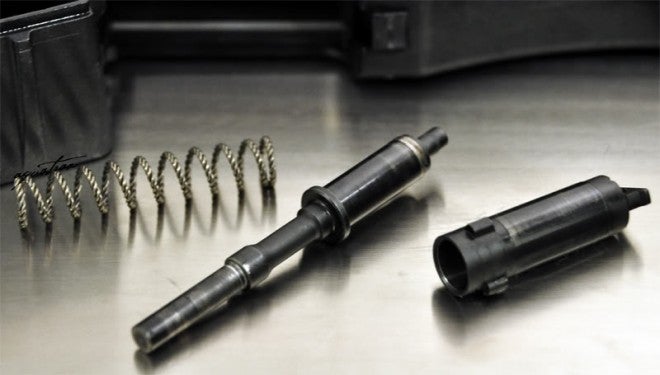
The VHS’s tappet piston. Note the sealing rings at the front of the piston, as well as its AUG-esque return spring. Unlike other designs, the tappet is contained within the gas plug for easy disassembly. Image source: calguns.net.
The Croatian VHS bullpup rifle is one of the new indigenous European rifle designs to hit the scene since the early 2000s. It utilizes a multi-lug Stoner-esque rotating bolt attached to a substantial bolt carrier, and is operated by a tappet that, like the AUG has both sealing rings and its own return spring. However, the VHS is otherwise fairly dissimilar to an AUG in construction, taking more from rifles like the SAR-21 and AK in the layout of the return spring and bolt carrier.
ARX-160
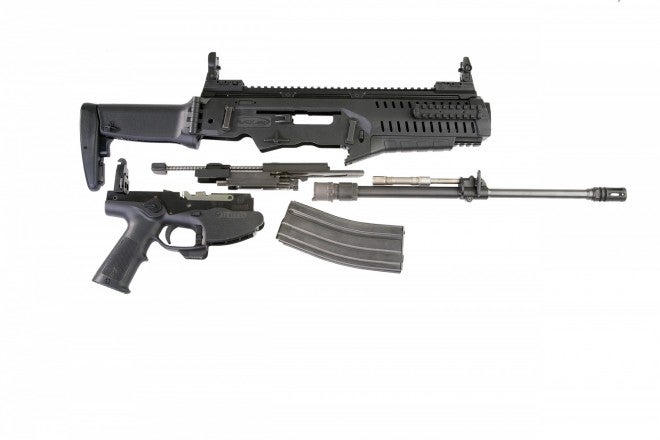
The Beretta ARX-160. Note the extremely large annular tappet in the fully extended position. Image source: shootingillustrated.com.
The design of the gas system of many rifles seems intent on proving the point I made in the first article: That a near-infinite amount of variation is possible between tappet and short-stroke operation. To drive this point home, the Beretta ARX-160 uses a massive annular tappet, that surrounds the gas block, to operate its bolt carrier. Without a return spring, this isn’t really a classical short-stroke design, but it certainly isn’t a traditional fast-moving, lightweight tappet, either.
SIG MCX
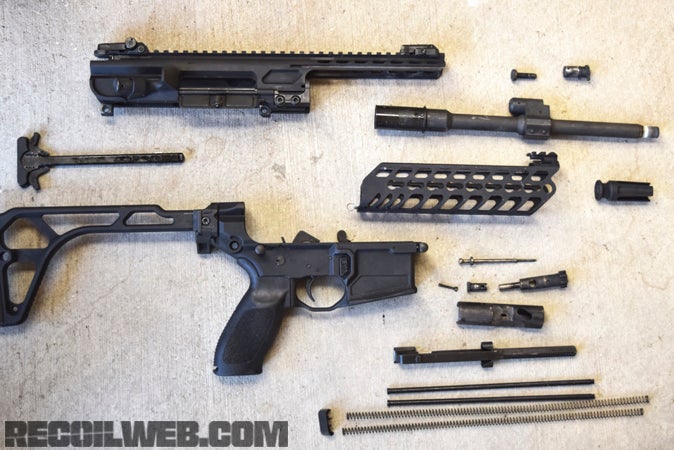
The SIG MCX, showing its AR-15-derived bolt and carrier, AR-18 derived return springs, and classic tappet gas operation, with a gas plug. Despite it’s resemblance to the FAL’s manual gas regulator, the SIG MCX’s regulator is automatic. Image source: recoilweb.com
The SIG MCX is an amagalm of many other popular designs. It borrows its classical tappet from the M1 Carbine/F2000/SCAR, its bolt carrier from the AR-15 (arguably the ZM Weapons LR300, specifically), and its return spring design from the AR-18. Note the substantial steel trunnion of the design.
Honorable Mention: G36/HK416/FX-05 Xiuhcoatl
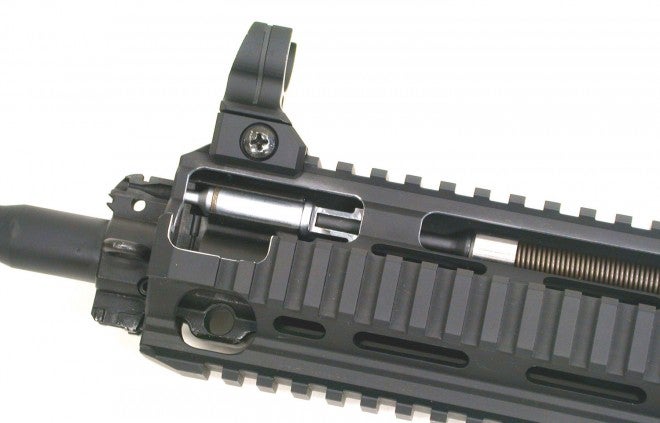
A cutaway of the HK416’s gas system. Visible is the front vent hole, the tappet and its sealing rings, and the operating rod that rides inside it. Image source: hkpro.com.
Generally considered to be straight derivatives of the AR-18, a description that itself bears a lot of truth, the G36 and its relatives nonetheless deviate away from the traditional AR-18 gas system, edging into territory close enough to tappet operation to earn them a mention. The gas system of these three rifles is very similar. Functionally, it works in a nearly identical manner to the segmented short-stroke design of the AR-18, but the initial force is provided by a tappet-like piston head, complete with sealing rings, with a female and a male end. As the piston head moves rearward, the male end retracts from the gas block and opens up a vent hole, relieving gas pressure to the system. Mechanically, this is identical to the AR-18’s system, but the tappet-esque piston head deserves some mention.
That concludes our tour of the tappet method of operation. If you want to read previous entries in this series, click through to read Part I: How It Works, Part II: Early Tappet Designs, and Part III: The M1 Carbine Cometh.
 Your Privacy Choices
Your Privacy Choices


